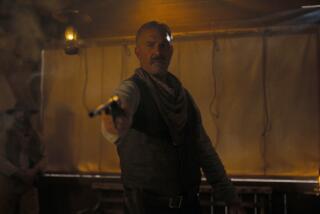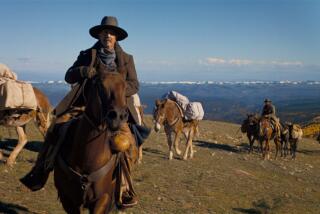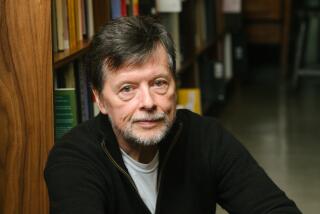‘Wagon Master’ rolls on
- Share via
A generous sampling of John Ford’s early career at 20th Century Fox can be found in “Ford at Fox,” the superb 2007 box set that remains the gold standard for classic-film reissues. Warner Home Video also has released a few fine Ford collections, including one devoted to the iconic partnership between Ford and John Wayne. But “Wagon Master” (1950), the film that the director called one of his personal favorites, is only now arriving on DVD.
Ford considered this small-scale project the “purest and simplest” of all his westerns, and it is precisely those qualities that account for its relative invisibility. Some scholars and historians, including Peter Bogdanovich (who can be heard on the commentary track of the new disc from Warner available this week), hail the film as the director’s masterpiece, but it’s always been easy to miss amid the towering monuments of the Ford canon.
The most laid-back and unpretentious of epics, “Wagon Master” was first released in the shadows of the Wayne-starring frontier-army pictures that came to be known as the cavalry trilogy: “Fort Apache” (1948), “She Wore a Yellow Ribbon” (1949) and “Rio Grande” (1950). It was while working with the Mormon extras on “Yellow Ribbon,” on location in Monument Valley, that Ford came up with the idea for “Wagon Master,” which chronicles the resolute westward journey of a group of Mormon settlers.
Shot quickly and cheaply, mostly around Moab, Utah, the film was something of a family affair. Ford’s son Patrick wrote the screenplay with Frank S. Nugent, a regular collaborator; his older brother Francis appears in the ensemble cast; his daughter Barbara worked as an assistant editor.
“Wagon Master” is at once the plainest and the fullest expression of Ford’s great theme: the emergence of a community. So committed is the film to the idea of a collective hero that there is no one central character, no leading man or marquee name. Instead of Wayne or Henry Fonda, “Wagon Master” is filled with lesser-known but familiar faces from the Ford stock company. And while some of the usual elements of the genre are accounted for, down to a climactic gunfight, there is not much of a plot.
This most leisurely and lyrical of westerns takes shape mainly as a series of encounters among disparate groups, as they clash, adapt to one another or become integrated into a larger whole.
Fleeing religious persecution, the Mormons, led by the gruffly pragmatic Elder Wiggs (Ward Bond), are headed for the fertile promised land of the San Juan Valley. To help guide his people on this perilous trek, Wiggs recruits a pair of young cowpokes, Travis (Ben Johnson) and Sandy (Harry Carey Jr.). As they cross deserts, rivers and mountains, the caravan swells. They stop to pick up a troupe of dissolute show people (including Joanne Dru) who have run out of water. The Cleggs, murderous outlaws on the lam, force themselves upon the pilgrims. There is a run-in with a tribe of Indians (peaceful, as it turns out).
In thrusting a ragtag group of outcasts together for a journey through harsh terrain, “Wagon Master” recalls 1939’s “Stagecoach,” the film that made Wayne a star and turned the western into a respectable genre. (The romantic subplot between the Johnson and Dru characters here also echoes the one between the Wayne and Claire Trevor characters from the earlier film.)
But even more than most westerns, “Wagon Master” resides in the realm of myth. The British critic Lindsay Anderson (who went on to direct “If. . .”) likened it to “an avant-garde western,” and indeed, the film is almost abstract in its simplicity. This is basically the story of America itself: an allegory of the settlement of the frontier and a meditation on the relationship between civilization and wilderness.
Fittingly, it derives much of its poetic force from cinematographer Bert Glennon’s panoramic black-and-white images of man in nature, of the pilgrims making their way -- in wagons, on horseback and on foot -- through the majestic landscape.
Practically a musical, “Wagon Master” is filled with frequent song and dance interludes and accompanied by a steady stream of hymns and ballads, performed by the popular country group the Sons of the Pioneers. The film’s open embrace of the most elemental myths is in stark contrast to the darker, deeply ambivalent visions that would soon take over the western, thanks to such filmmakers as Budd Boetticher and Sam Peckinpah, and even Ford himself (in “The Searchers” and “The Man Who Shot Liberty Valance”). The last gasp of the classical western, “Wagon Master” is also the pinnacle of the genre’s optimistic ideals.
--
More to Read
Only good movies
Get the Indie Focus newsletter, Mark Olsen's weekly guide to the world of cinema.
You may occasionally receive promotional content from the Los Angeles Times.










